Advertisements
What are the Parts of Palate?
Palate forms the roof of the proper oral cavity and is divided into two parts:
- Hard palate
- Soft palate
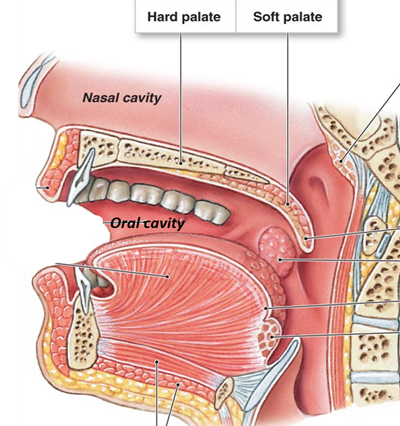
Hard (Bony) palate
It forms the anterior 4/5th of the palate and is formed by:
- Palatine processes of maxillae (forms the anterior 2/3rd)
- Horizontal plates of palatine bones (forms the posterior 1/3rd).
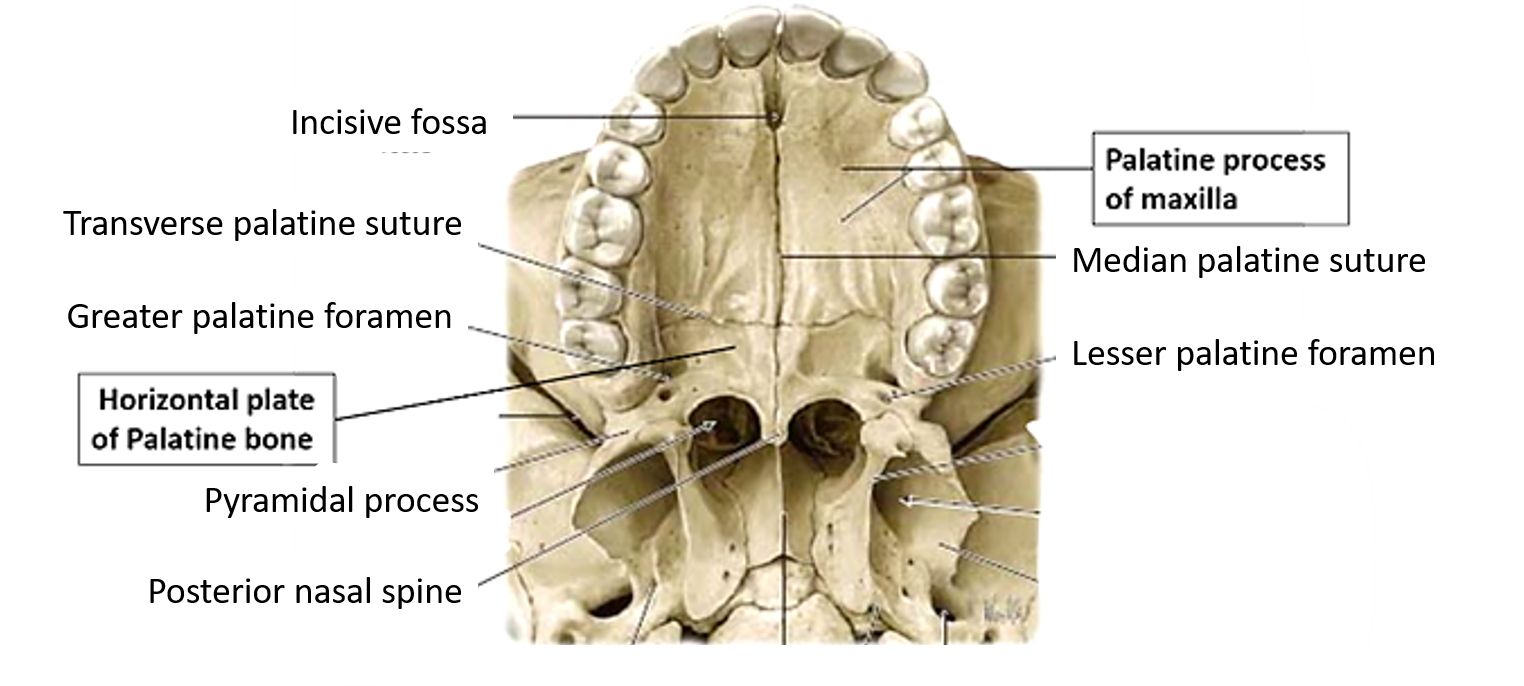
Soft palate
It forms the posterior 1/5th of the palate.
- It is a fibromuscular mobile flap that is attached anteriorly to hard palate. It is a muscular curtain between nasopharynx & oropharynx.
- It has conical downward projection from midline called uvula.
- Soft palate has two surfaces and two borders (in resting position).
- Surfaces:
- Anterior (oral) surface: It faces the oral cavity.
- Posterior surface: It is continuous with the floor of the nasal cavity.
- Borders:
- Superior border is attached to the posterior border of hard palate.
- Inferior border is free and a small conical projection called uvula hangs down from its middle.
- Laterally: Two folds of mucous membrane each containing a muscle extend down from the soft palate to the tongue and pharynx.
- Anterior palatoglossal fold containing palatoglossus muscle reaches the tongue at the junction of its anterior 2/3rd and posterior 1/3rd.
- Posterior palatopharyngeal fold containing palatopharyngeus muscle descends on the lateral wall of the oropharynx.
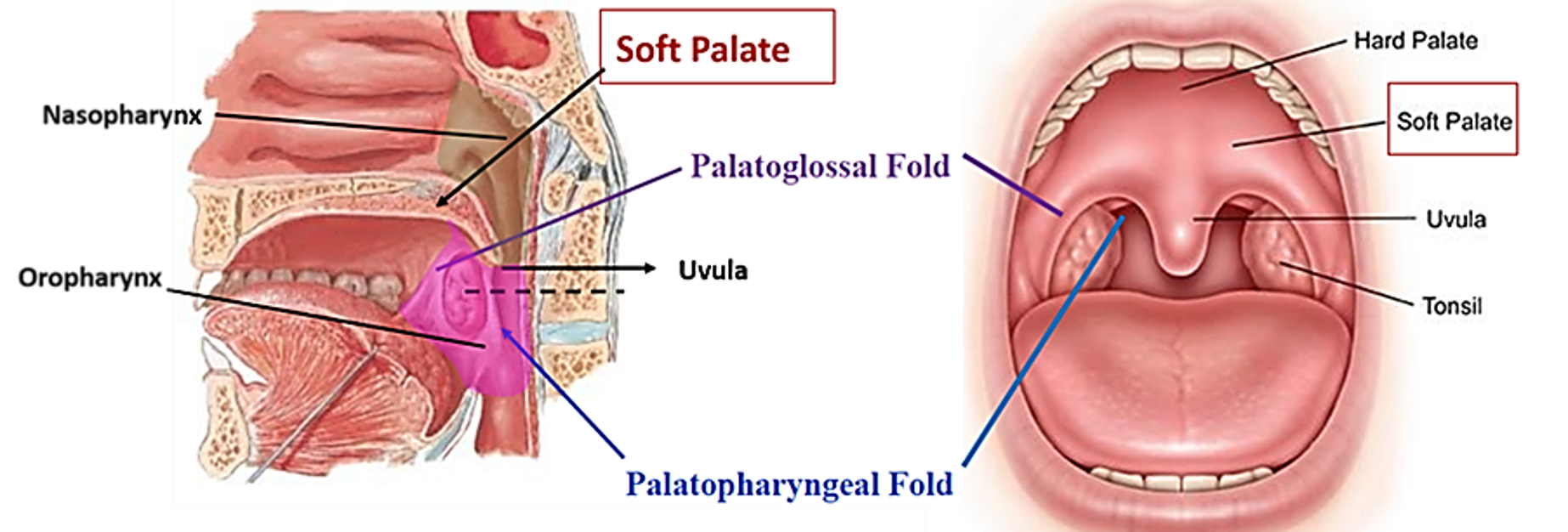
What are the Structural Components of Soft Palate?
The structures forming soft palate are arranged in following five layers from oral surface to pharyngeal surface.
- Stratified squamous non-keratinized epithelium
- Palatine glands
- Palatine aponeurosis and muscles
- Palatine glands
- Pseudostratified ciliated columnar epithelium
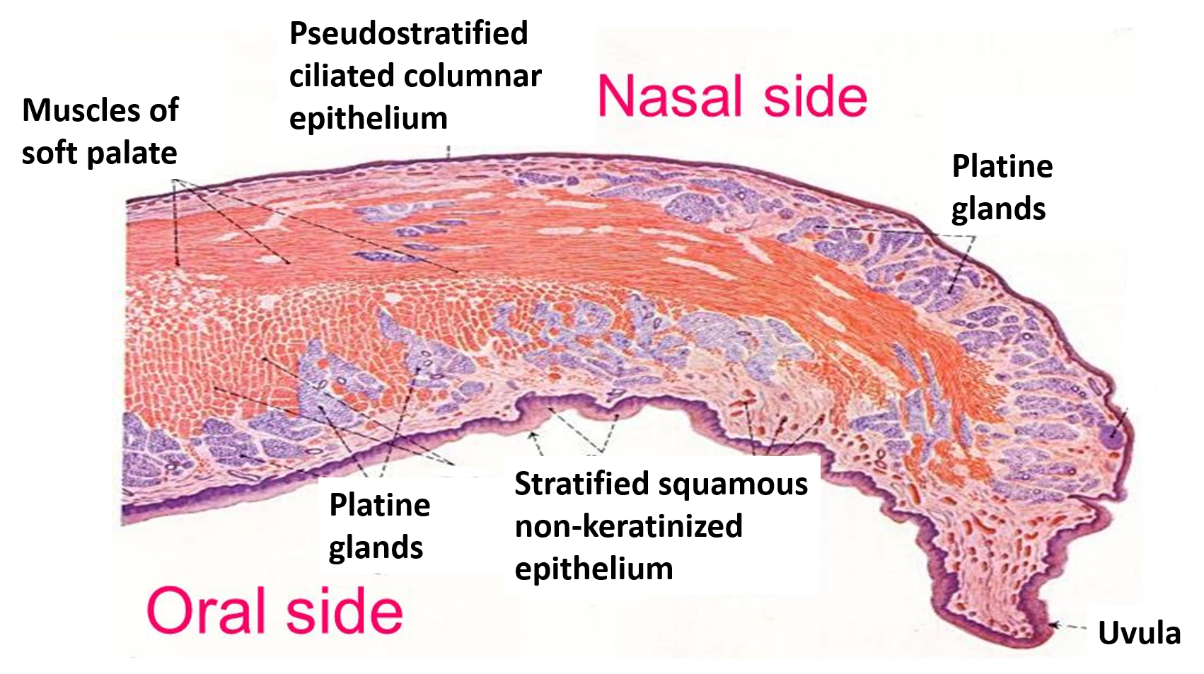
Write the Origin, Insertion, Action and Nerve Supply of Muscles of Soft Palate.
Muscles of soft palate: Soft palate consists of following five pairs of muscles:
- Two muscles enter from above (take origin from the base of skull):
- Tensor veli palatini
- Levator veli palatini
- Two muscles descend own from the palate (take origin from palatine aponeurosis):
- Palatoglossus
- Palatopharyngeus
- One muscle descends into the uvula in the midline:
- Musculus uvulae
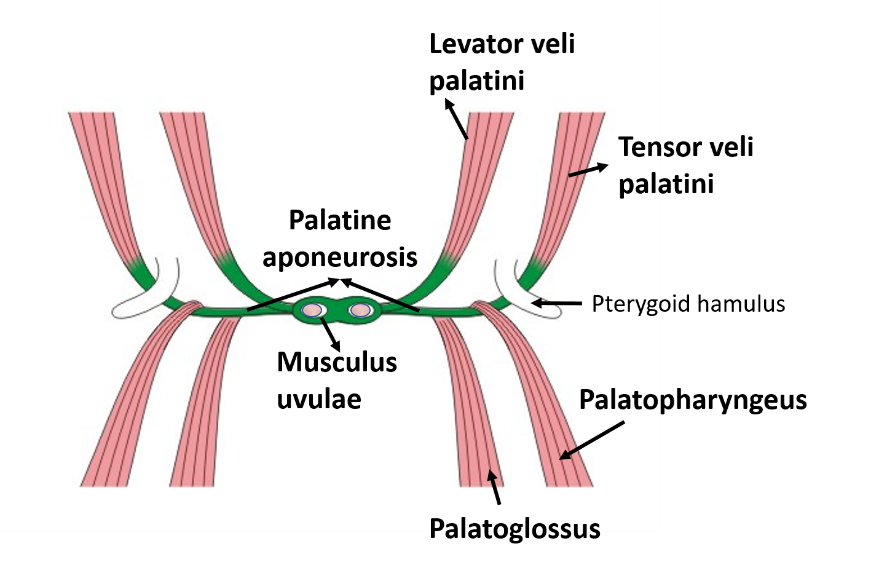
| Muscles | Origin | Insertion | Action |
|---|---|---|---|
| Tensor veli palatini | Lateral surface of auditory tube, spine of sphenoid, scaphoid fossa | Its tendon hooks around the pterygoid hamulus and forms aponeurosis which is attached to the inferior surface of hard palate (behind the palatine crest) and to the posterior border of hard palate | Tightens the soft palate and helps in opening the auditory tube |
| Levator veli palatini | Inferior surface of petrous part of temporal bone near its apex, medial surface of auditory tube | Upper surface of palatine aponeurosis | Elevation of soft palate and helps in opening the auditory tube |
| Palatoglossus | Inferior surface of palatine aponeurosis | Side of tongue at the junction of its oral and pharyngeal part | Elevation of tongue |
| Approximation of the two palatoglossal arches to close the oropharyngeal isthmus | |||
| Palatopharyngeus | Superior surface of palatine aponeurosis and posterior border of hard palate. It arises by two fasciculi which are separated by levator veli palatini | Posterior border of lamina of thyroid cartilage | Pulls the pharyngeal and laryngeal walls upwards during swallowing |
| Musculus uvulae | Posterior nasal spine and palatine aponeurosis | Mucosa of uvula | Shortens and raises the uvula |
Attachment of Muscles of Palate
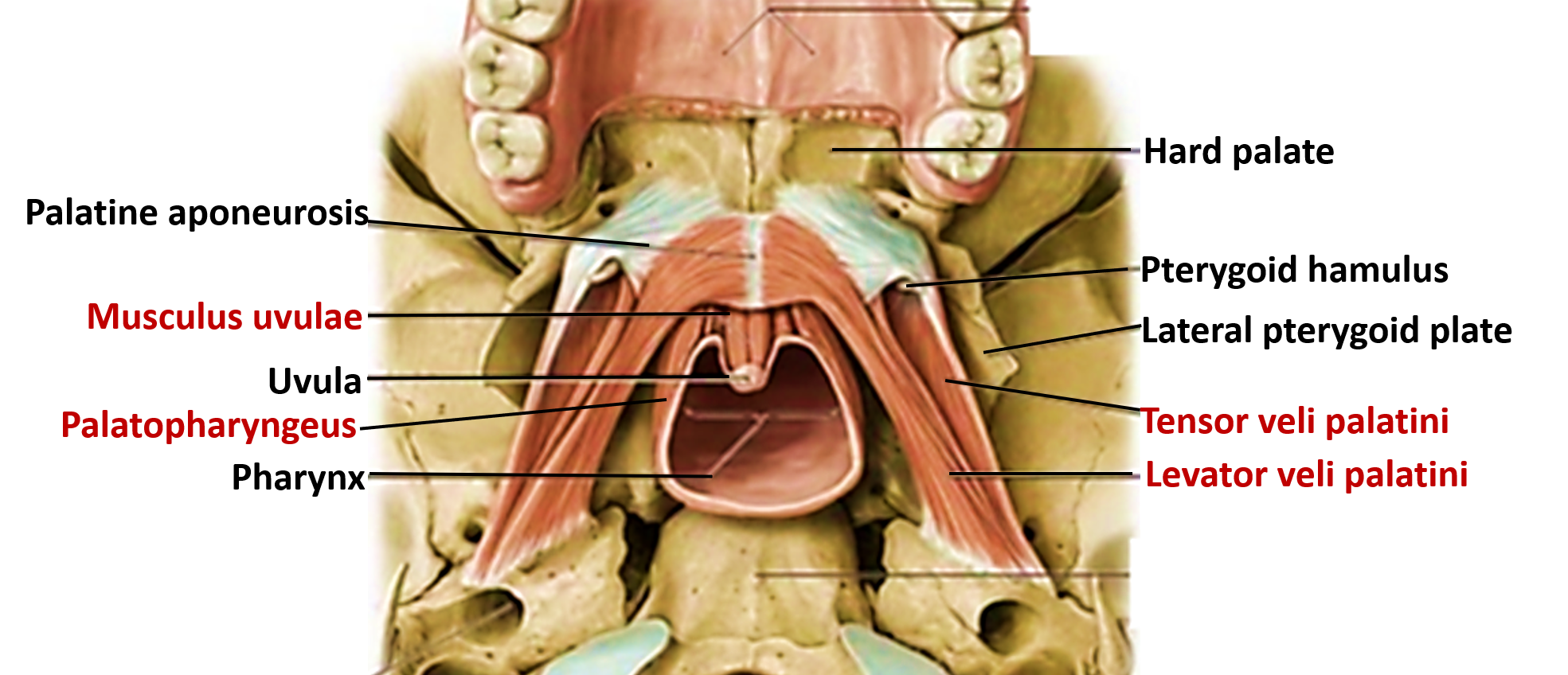
What are the Functions of Soft Palate?
Functions of soft palate are:
- Separates oropharynx from nasopharynx during swallowing.
- Isolates oral cavity from oropharynx during chewing so that breathing is not affected.
- Helps to modify the quality of voice by varying the degree of closure of pharyngeal isthmus.
- Protects nasal mucosa during sneezing by appropriately directing the blast of air through nasal and oral cavity.
- Prevents the entry of sputum into nose during coughing.
Describe the Arterial and Nerve Supply of Palate.
Arterial supply of hard palate
Hard palate is supplied by greater palatine arteries (branch of maxillary artery)
Nerve supply of hard palate
Hard palate is supplied by the branches from pterygo-palatine ganglion from maxillary nerve viz.:
- Greater palatine nerve
- Nasopalatine nerve
Arterial supply of soft palate
Soft palate is supplied by the following arteries:
- Lesser palatine arteries (branches of maxillary artery).
- Ascending palatine branch of facial artery.
- Palatine branches of ascending pharyngeal artery.
Nerve supply of soft palate
- Sensory:
- Lesser palatine (from maxillary nerve via pterygopalatine ganglion)
- Glossopharyngeal nerve.
- Motor:
- All the muscles of soft palate are supplied by cranial root of accessory via vago-accessory complex except tensor veli palatini which is supplied by nerve to medial pterygoid (branch of mandibular nerve).
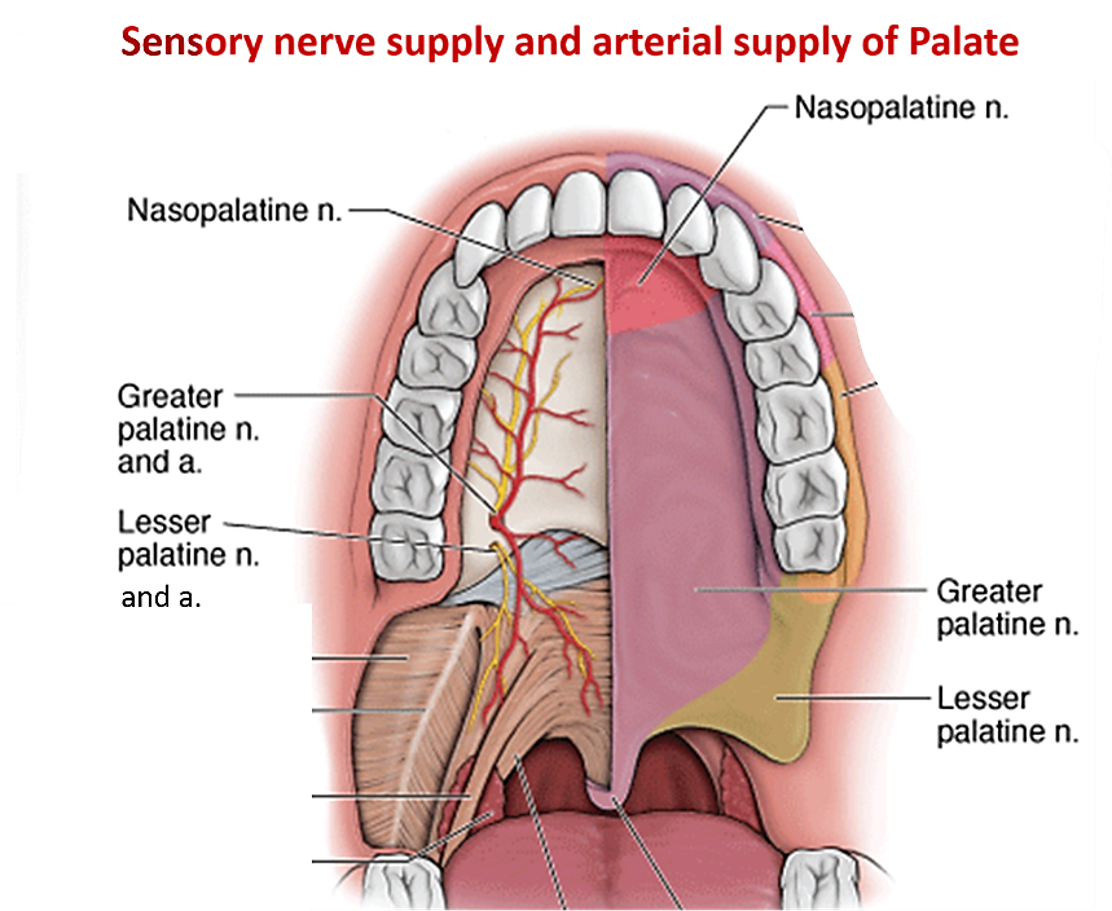
Applied Aspect
Paralysis of muscles of soft palate results in
- Nasal regurgitation of liquids.
- Nasal twang in voice.
- Flattening of palatal arch on the side of lesion.
- Deviation of uvula, opposite to the side of lesion.
For Cleft palate [Click Here]
